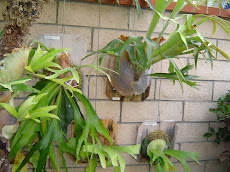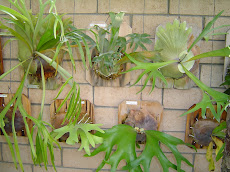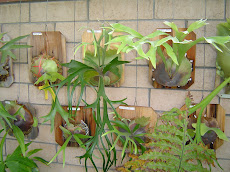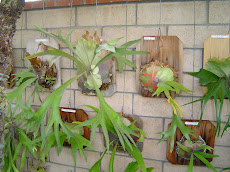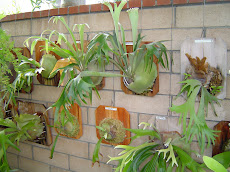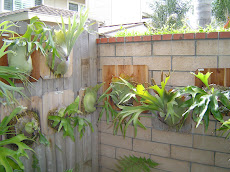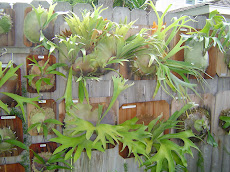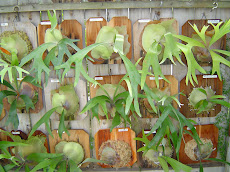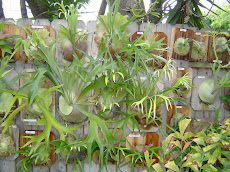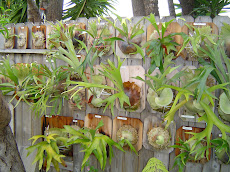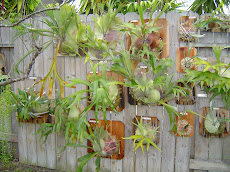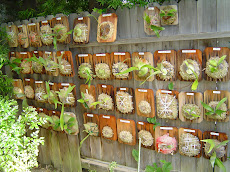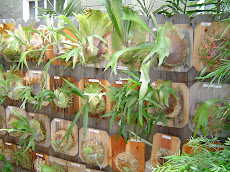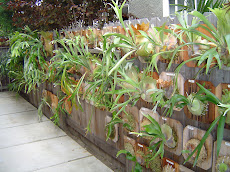The Generosity of Charles Rowden
October of last year Charles Rowden - world renown orchid photographer, platycerium hobbyist and previous customer of mine experienced a personal "life-changing" event. Due to this event he could no longer care for his collection and asked if I would be interested in taking his collection. I was hesitant at first not knowing what his collection consisted of, nor the price that he would demand. Charles saw my hesitation, and immediately stated that it was mine if I wanted it - no charge! He knew that it would be left in good hands. I accepted his generous offer, the collection included the following ferns: Alcicorne; Little Wil; Stemaria HD 317 (attributed to the late Dr. Barbara Joe Hoshizaki); Jimmy Davis; Mt. Lewis; Willinckii; Coronarium (2ea); Huge Superbum; Huge Elephantotis; Huge Elemaria; Callard; Huge Wandae; Blueboy; Lemoinei; Hillii Philippine Form; Willinckii Celso (did not survive); Madagascariense and many other very large unknown bifurcatum cultivars. But the biggest surprise, was the Durval Nunes , he stated that it was the only one available west of the Mississippi.
Normally, my stags stay outside all winter long, but I did bring in the Coronarium, Stemaria HD 317, Mad and the Durval Nunes and I'm glad to report, there is new growth on all but he Mad (it did not survive).
On a personal note, on 11/18/2011 my first grandchild was born, her name is Noah Louise Gauci - the proud parents are Tim & Codi Gauci. She has been such a blessing and brings such joy to this old curmudgeon. I'm hoping some of her first words will include platycerium.
International Procurements - Part Deux
The willinckii cultivars that I had procured from Siam Exotica have
been doing so well, despite the beating they took in Customs, I decided to procure another willinckii cv. Manda; willinckii cv. Bogor and a new bifurcatum cultivar by the name of Siam Willin'. These came through Customs practically unscathed, just one frond creased and a couple tips broken off. It may be because this shipment of stags was overall smaller than the previous one and hence less likely to incur damage. None the less, I am very happy with the current shipment and would not hesitate to purchase additional hard-to-get cultivars from Siam Exotica in the future. Just a note, the ferns were in my hands in nine (9) days -from Thailand to Huntington Beach via EMS through LAX.
International Procurements
Well, I finally got enough courage to procure a few "hard to get" willinckii cultivars from Thailand. It is quite an investment. While the platycerium are well priced for the size, the shipping costs and the phyto certificate really add to the per unit price. I fully expected the ferns to take a beating since it took nine (9) days to ship door to door (EMS shipping), plus being inspected and sprayed by customs - I truly suspect that this is where most of the damage occurred. The fertile fronds sustained the majority of the damage , i.e. torn, creased, split or the ends of the frond tips broken off.
All that to say, that they will survive and in fact I am seeing new fertile fronds emerging on all three cultivars. Overall, I would grade the experience a 6 out of 10. It will definitely take the whole year to see how these stags acclimate to the Southern California coastal climate.
The three (3) willinckii cultivars are Paul, Manda, and Bogor and were procured from Siam Exotica. Napaporn Somkaew was the gentleman I was dealing with. There was a language barrier but not insurmountable, both parties got their messages across.
The downside to this experience was the time it takes to receive the fern door to door, the stress the plant endures during transit and the language barrier. The upside is having three (3) new ferns in the collection and waiting to see if they can survive the year in Southern CA.
Interstate Procurement
I just recently procured a willinckii cv. Mayii from Phil Crabb and I wasn't disappointed. The cultivar was healthy, not a flaw on it and was well packaged. It was mounted on a 10x7 redwood backboard immediately and as of this date is doing quite well.
History:My good friend Floyd introduced me to this fern. Initially content with the staghorn fern that he gave me, shortly, I ran across others that looked similar but obviously not the same and others that were just different. After some basic research, there were some that I indeed would like to have. One fern led to another, and six years later, almost every inch of fencing in the backyard has been utilized to hang staghorn ferns on.
October of last year Charles Rowden - world renown orchid photographer, platycerium hobbyist and previous customer of mine experienced a personal "life-changing" event. Due to this event he could no longer care for his collection and asked if I would be interested in taking his collection. I was hesitant at first not knowing what his collection consisted of, nor the price that he would demand. Charles saw my hesitation, and immediately stated that it was mine if I wanted it - no charge! He knew that it would be left in good hands. I accepted his generous offer, the collection included the following ferns: Alcicorne; Little Wil; Stemaria HD 317 (attributed to the late Dr. Barbara Joe Hoshizaki); Jimmy Davis; Mt. Lewis; Willinckii; Coronarium (2ea); Huge Superbum; Huge Elephantotis; Huge Elemaria; Callard; Huge Wandae; Blueboy; Lemoinei; Hillii Philippine Form; Willinckii Celso (did not survive); Madagascariense and many other very large unknown bifurcatum cultivars. But the biggest surprise, was the Durval Nunes , he stated that it was the only one available west of the Mississippi.
Normally, my stags stay outside all winter long, but I did bring in the Coronarium, Stemaria HD 317, Mad and the Durval Nunes and I'm glad to report, there is new growth on all but he Mad (it did not survive).
On a personal note, on 11/18/2011 my first grandchild was born, her name is Noah Louise Gauci - the proud parents are Tim & Codi Gauci. She has been such a blessing and brings such joy to this old curmudgeon. I'm hoping some of her first words will include platycerium.
International Procurements - Part Deux
The willinckii cultivars that I had procured from Siam Exotica have
been doing so well, despite the beating they took in Customs, I decided to procure another willinckii cv. Manda; willinckii cv. Bogor and a new bifurcatum cultivar by the name of Siam Willin'. These came through Customs practically unscathed, just one frond creased and a couple tips broken off. It may be because this shipment of stags was overall smaller than the previous one and hence less likely to incur damage. None the less, I am very happy with the current shipment and would not hesitate to purchase additional hard-to-get cultivars from Siam Exotica in the future. Just a note, the ferns were in my hands in nine (9) days -from Thailand to Huntington Beach via EMS through LAX.
International Procurements
Well, I finally got enough courage to procure a few "hard to get" willinckii cultivars from Thailand. It is quite an investment. While the platycerium are well priced for the size, the shipping costs and the phyto certificate really add to the per unit price. I fully expected the ferns to take a beating since it took nine (9) days to ship door to door (EMS shipping), plus being inspected and sprayed by customs - I truly suspect that this is where most of the damage occurred. The fertile fronds sustained the majority of the damage , i.e. torn, creased, split or the ends of the frond tips broken off.
All that to say, that they will survive and in fact I am seeing new fertile fronds emerging on all three cultivars. Overall, I would grade the experience a 6 out of 10. It will definitely take the whole year to see how these stags acclimate to the Southern California coastal climate.
The three (3) willinckii cultivars are Paul, Manda, and Bogor and were procured from Siam Exotica. Napaporn Somkaew was the gentleman I was dealing with. There was a language barrier but not insurmountable, both parties got their messages across.
The downside to this experience was the time it takes to receive the fern door to door, the stress the plant endures during transit and the language barrier. The upside is having three (3) new ferns in the collection and waiting to see if they can survive the year in Southern CA.
Interstate Procurement
I just recently procured a willinckii cv. Mayii from Phil Crabb and I wasn't disappointed. The cultivar was healthy, not a flaw on it and was well packaged. It was mounted on a 10x7 redwood backboard immediately and as of this date is doing quite well.
History:My good friend Floyd introduced me to this fern. Initially content with the staghorn fern that he gave me, shortly, I ran across others that looked similar but obviously not the same and others that were just different. After some basic research, there were some that I indeed would like to have. One fern led to another, and six years later, almost every inch of fencing in the backyard has been utilized to hang staghorn ferns on.
Initially, the procurements were made on e-bay, but eventually, I connected with some of the locals (and not so local) that grow, sell, trade and/or show these attractive ferns. The following list is by no means comprehensive and not in any particular order, but they were instrumental in furnishing the platys that have become part of my collection: Floyd Whitton; Tony Barrett; Mark Mese; Charles Alford; Doug Eckel; Miles Goodman; Charles De France; Kaleb Cullison; Jodie Schumaker; Paul Isley; Joe Elmore; Saleem Samia; Chad Wunderlich; Jim Boehme; Mark D. Scott; Don Callard; Oscar Olson and Larry Kelsey.
Not sure why, but the majority of staghorn fern owners that I've met are men. It may be that the ease of care, the sturdy but simple structure of this fern and the lack of tilling soil appeals to us more than something fragile with more color and complexity that seasonally vanishes after much nurturing. A well grown platycerium remains quite attractive (in its own way) year round and will give you a sense of accomplishment that they are indeed alive and visible, not some bulb or seed sitting in the ground awaiting the right conditions to germinate.
I wish I could say that every staghorn fern that was purchased survived. I've tried a few of the more temperamental ones (at least for me), ones that most collectors can raise - elephantotis; wandae; coronarium and stemaria - all made it through the summer, spring and fall, but died in the winter - even sheltering them as much as possible, the temperature may have got to low for them. I am normally successful with most cultivars, but have had some die on me. Lessons learned - your chance of successfully growing any staghorn fern is directly proportional to its size. The larger the specimen, the greater the chance of its survival, all other factors (climate, location, insects, nutrients) being equal. Of course, failure will not stop me from "experimenting" with new types - I just procured a hybrid named P. x Elemaria ( elephantotis x stemaria - neither of which I was successful at keeping alive individually). Maybe the hybrid will fend off all my attempts to take care of it and survive. Also purchased was an African cultivar by the name of P. Callard, both from Charles Alford and both are very nice size and healthy - we'll see how they do.
General Information - purchase A Guide to Platycerium Ferns and Staghorn Ferns ... A Hobbyist's Handbook: By Roy Vail there is a lot of good information on all 18 species, hybrids and cultivars that I will not rehash here. See the below links that I believe will help you make an educated decision as to wether or not you want to pursue a relationship with Platycerium:
I wish I could say that every staghorn fern that was purchased survived. I've tried a few of the more temperamental ones (at least for me), ones that most collectors can raise - elephantotis; wandae; coronarium and stemaria - all made it through the summer, spring and fall, but died in the winter - even sheltering them as much as possible, the temperature may have got to low for them. I am normally successful with most cultivars, but have had some die on me. Lessons learned - your chance of successfully growing any staghorn fern is directly proportional to its size. The larger the specimen, the greater the chance of its survival, all other factors (climate, location, insects, nutrients) being equal. Of course, failure will not stop me from "experimenting" with new types - I just procured a hybrid named P. x Elemaria ( elephantotis x stemaria - neither of which I was successful at keeping alive individually). Maybe the hybrid will fend off all my attempts to take care of it and survive. Also purchased was an African cultivar by the name of P. Callard, both from Charles Alford and both are very nice size and healthy - we'll see how they do.
General Information - purchase A Guide to Platycerium Ferns and Staghorn Ferns ... A Hobbyist's Handbook: By Roy Vail there is a lot of good information on all 18 species, hybrids and cultivars that I will not rehash here. See the below links that I believe will help you make an educated decision as to wether or not you want to pursue a relationship with Platycerium:
Charles Alford site: http://www.rareferns.com/
Louwrens Opperman & Roy Vail site: http://www.platycerium.co.za/
Doug Eckel site: http://http//home.earthlink.net/~decho/page2.html
Chad Wunderlich site: www.platyceriumferns.com/
Jim Boehme video: www.youtube.com/watch?v=i8OwWqa-Hr0
Other lessons learned:
1) Moss & Floss: When mounting pups onto new boards your hands tend to get soft due to handling the wet sphagnum (moss) and if using 40lbs monofiliment line (floss) to attach, you have to be careful that you don't let the line cut you - for me, its seems always to be at the first knuckle of my right index finger. So if I'm going to board a lot of pups, I'll wrap my knuckle with duct tape.Louwrens Opperman & Roy Vail site: http://www.platycerium.co.za/
Doug Eckel site: http://http//home.earthlink.net/~decho/page2.html
Chad Wunderlich site: www.platyceriumferns.com/
Jim Boehme video: www.youtube.com/watch?v=i8OwWqa-Hr0
Other lessons learned:
2) Pup Procurement: If you are purchasing pups from a supplier that is out of your general climate zone, buy as early in the spring as possible, this will give the pup time to acclimate, thus survivability is enhanced.
3) Pup Removal: If possible, a general rule of thumb is to wait until the pup is the size of a CD. Of course there are always exceptions to a rule. Use your experience and discretion.
4) Wisdom: If you find someone in your general area (growing conditions similar) that has had success with platycerium, LISTEN to their stories and tips and their lessons learned. Everything that your thinking about trying, they have already done. It will save you a lot of time, money and keep you off the rabbit trails.
5) Men: Are hunter/gatherers - they're search is usually for a specific species or cultivar and will make sure that one or more are available before they put the effort out to come to your residence. If you don't have what they're after, redirect them to another grower who does - if known.
6) Women: Are shoppers - They start with an idea of what they're after and if found, will buy, but give them time to look around and see if anything else catches their eye. They like their staghorns clean, trimmed, on new wood and insect free - especially no spider webs.
7) Clean Up: After mounting a pup, trim off the excess sphagnum moss immediately, don't wait until you get around to it. I've waited too long sometimes and end up cutting off a new pup(s) hidden in the moss that had just started.
8) Moss Types: There are two types of moss that I prefer to use, because they are so easy on the hands. The New Zealand sphagnum moss and/or the Chilean sphagnum moss. The New Zealand moss is a longer cut of moss, it is slower in taking up water and slower in releasing it. The Chilean moss is cut shorter and takes water up quicker and releases it quicker. When using the straight Chilean Moss you'll need to rigorously secure the moss to the board due to the shorter cut. Personally, I use a blend of both. You can get a 5kg bale of Chilean moss for about the same price as a 3kg bale of NZ moss.
9) Quarantine: Anytime you receive a new platycerium into your collection, it is wise to keep it separate from the rest for a short (approximately 2 weeks) period of time so as to make sure your new fern is pest free.
10) Fern Societies and Shows - Are a great place to meet locals who grow and to pick up some tips and ideas and staghorns.

